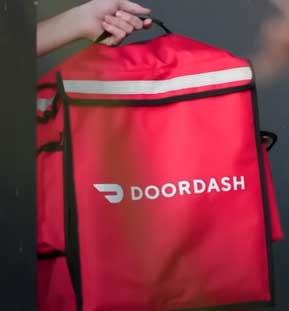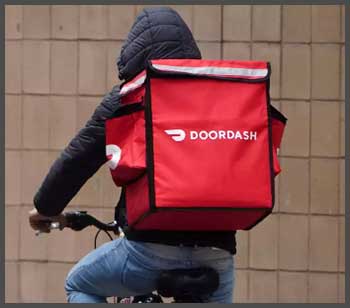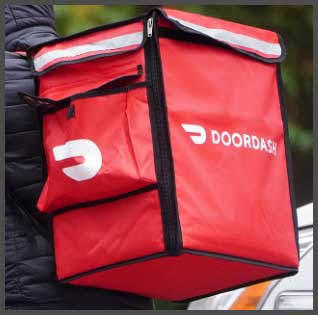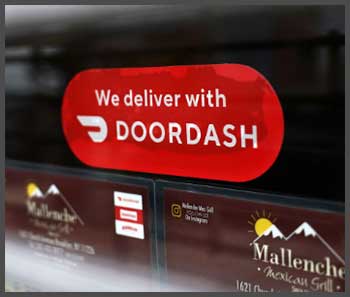DoorDash has become the go-to food delivery app for many people across the United States. With just a tap of a button, you can have meals from your favorite local restaurants delivered straight to your door.
But DoorDash customers have started to notice that prices on the app tend to be more expensive compared to ordering directly from the restaurant.
Below we’ll take a comprehensive look at the key factors that make using DoorDash’s services so costly compared to takeout or other delivery options.
Delivery Fees And Service Charges
One big contributor to the high prices on DoorDash is all of the extra fees and charges they tack on top of your order:

- Delivery Fee – This covers the base cost of having a DoorDash driver pick up your food and deliver it. Delivery fees can vary but usually range between $3-5 per order.
- Service Fee – This is DoorDash’s charge for facilitating and processing the order. Service fees are typically 10-15% of the order subtotal.
- Taxes – Sales tax gets added to the order total, just like dine-in orders. Some cities also charge special taxes or fees for delivery orders.
- Tip – You’re expected to tip your driver, usually around 10-20% of the order total.
Once you factor in all of these charges, your $20 burrito bowl suddenly costs $25-30. The various fees and tip easily add 25-35% to the order cost compared to takeout.
Reasons For Doordash Being So Expensive
- Menu Prices Are Marked Up
In addition to tacking on all kinds of fees, DoorDash also marks up the menu prices themselves on many orders. This means you’ll pay more for the actual food items compared to if you ordered takeout directly from the restaurant.
DoorDash allows restaurants to set inflated prices to help offset the commission fees the restaurants have to pay. These markups usually add about 10-30% onto the regular menu prices. A $12 entree might cost $15-16 on DoorDash before other fees even get added.
These inflated item prices allow DoorDash to mask the impact of their fees and make the delivery charges seem smaller in comparison. But you end up paying a premium either way.
- High Commission Rates for Restaurants
So why do restaurants let DoorDash get away with hiking up their menu prices? It comes down to the costly commission fees restaurants have to pay to be on the platform.
DoorDash typically charges restaurants a 15-30% commission fee on every order placed through their marketplace. These high commissions eat away at the restaurant’s profit margins on each DoorDash order.
By allowing DoorDash to inflate the menu prices, restaurants can offset these commissions somewhat so they’re not losing money on each order.
DoorDash also charges additional fees for advertising, placement prominently on the app, and other “upsells” to restaurants. So restaurants end up paying even higher back-end costs to access DoorDash’s huge customer base.
This gives DoorDash leverage to charge restaurants high commission rates. And those inflated costs ultimately get passed on to the customer in the form of higher menu prices.
- Extra Charges for Customization

Want to add avocado to your burrito or swap in a side salad instead of fries?
These kinds of special requests will cost you extra when ordering through DoorDash.
The app tacks on additional fees for each customization or modification you add to an order.
While restaurants don’t usually charge extra for special instructions on takeout orders, DoorDash turns customization into another revenue stream.
These per-item add-on fees are typically small – just $1-2 per special request. But they can really add up if you have several customizations to an order, especially for larger parties.
Before you know it, all those extra avocados and dressing substitutions have inflated your bill by another $5-10.
- Lack of Transparent Pricing
Another issue that inflates costs for DoorDash users is the app’s confusing and sometimes misleading pricing practices.
In some cases, DoorDash lists menu prices on its app and website that don’t match the prices the restaurant itself lists on its own online menus. This makes it hard to comparison shop and determine if you’re getting overcharged until you examine the total.
DoorDash also obscures what the full cost will be until after you’ve already placed an order. Service fees and delivery charges are shown as estimates only until you finish checkout. Then the total is often higher than the original estimate.
This lack of transparent pricing means customers can’t accurately assess what a delivery order will really cost them upfront. DoorDash makes it hard to get an apples-to-apples comparison between delivery and takeout pricing.
- Premium Charges for DashPass Members
DoorDash also finds creative ways to charge more even for customers who pay for its subscription service, DashPass.
With DashPass, you pay a monthly or yearly fee to get unlimited free deliveries on orders over $12. But there’s a catch.

Even with a DashPass membership, DoorDash will still sometimes tack on “priority fees” to deliver your order faster during busy times.
Non-members already have to pay a delivery fee per order, so DashPass is supposed to remove those charges in exchange for the subscription cost.
But priority fees have essentially become replacement delivery fees for DashPass members.
This allows DoorDash to continue generating revenue from deliveries that are supposed to be included free for DashPass members.
- Customer Demographics Who Tip Well
Here’s one reason for DoorDash’s high costs that has nothing to do with fees or commissions: the customer demographics simply tend to tip well.
The typical DoorDash user tends to be middle or upper-middle class. They’re willing to pay the costs and tips for the convenience of food delivery. Many customers are tech-savvy professionals with disposable income.
These demographics recognize that delivery drivers depend on tips as a major part of their compensation. Because of this, DoorDash orders tend to receive higher tips compared to something like a pizza delivery order.
Since tips often account for a large percentage of the total order cost, the generously tipping customer base contributes to the higher order totals on DoorDash. They’ve found a price point that consumers have proven willing to pay for the service provided.
Why Does DoorDash Charge Such High Service Fees?
DoorDash’s service fee is one of the largest add-on charges they apply to orders. Here’s a deeper look at why they are able to charge a 10-15% service fee:
- It helps cover their operating costs for things like marketing, developing the app, background checks, and insurance.
- As a private company, DoorDash is focused on profitability. The high service fees enable them to turn a profit on each transaction.
- The fees help supplement the base pay that drivers receive per order. This allows DoorDash to keep driver pay rates low.
- DoorDash has established market dominance as the top food delivery app. This gives them leverage to charge higher fees than competitors while still attracting customers.
- Lack of transparency around breakdown of fees means customers perceive the service fee as a reasonable charge for the convenience provided.
The high service fees have become key to DoorDash’s business model. And because of convenience and lack of fee awareness, customers have been willing to pay the premium.
How Does DoorDash Pricing Compare to Uber Eats?
DoorDash and Uber Eats make up the two largest on-demand food delivery apps. But is one more affordable for customers than the other?
When examining the pricing and fee structure between the two, DoorDash tends to come out slightly more expensive per order on average:
- DoorDash service fees range from 10-15% compared to 7-10% for Uber Eats.
- DoorDash also inflates pre-tax menu prices more than Uber Eats.
- During especially busy times, DoorDash will sometimes impose “priority fees” for quick delivery – Uber Eats does not.
However, there are some ways Uber Eats makes up the difference:
- Uber Eats occasionally has lower minimum order sizes to get free delivery.
- Uber uses dynamic “surge pricing” during peak high-demand times, significantly inflating fees.
- Originally, Uber’s tipping default was much lower than DoorDash’s recommended amounts.
Ultimately, the cost difference depends a lot on location, time of day, and other factors. But DoorDash does appear to inflate menu prices and tack on fees slightly more across the board.
What Is The Most Affordable Food Delivery Service?
For customers trying to save money on delivery, what are the cheapest alternatives to DoorDash? Here are some options to compare:

- Uber Eats – Overall lower service fees make it slightly cheaper than DoorDash in many cases.
- Grubhub – Grubhub tends to have lower fees compared to major competitors, but has fewer restaurant choices.
- Postmates – Happy hour deals help offset fees. But order minimums are higher.
- Slice – Specializes in pizza delivery and offers consistent flat fees.
- GoPuff – No delivery fees and fast service but limited to convenience store items.
- Restaurant Apps – Ordering directly through restaurant apps can avoid most of the middleman fees and markups added by third-party apps.
No delivery app will match the price of ordering takeout directly. But comparing fees across apps can help find the most cost-effective option based on order specifics. Skipping any optional priority fees or addons can also help control costs.
Why Does DoorDash Pricing Vary So Much?
With all of these fees and price markups, why does the total cost of a DoorDash order fluctuate so much? There are a few key factors that impact pricing:
- Time of Day – DoorDash increases fees during peak dinner rush hours when demand is highest.
- Distance – The farther away the restaurant, the higher the delivery fee. Distance-based fees get charged on top of the base delivery fee.
- High Demand – Prices spike in bad weather or other conditions when delivery demand surges.
- Restaurant Popularity – More popular restaurants that are “in high demand” get hit with higher fees.
- Duration – Fees go up if an order takes longer to complete during busy times.
- Promotions – Discounts or waiving fees for first-time users affects costs.
- Driver Supply – Limited drivers means higher fees to entice drivers to accept orders.
Because so many variable factors impact what fees get applied, customers can wind up paying very different amounts for what seem like similar orders.
Is The Convenience Worth The Cost Of Doordash?
At the end of the day, is forking over the high fees and charges on DoorDash worth it for the convenience? Opinions vary among customers.
For
- Saves time and effort of pickup or cooking.
- Provides access to a wide range of restaurants.
- Useful in bad weather when you can’t drive.
- Appeals to people with busy schedules or limited mobility.
- Offers a seamless ordering experience.
Against
- Fees often add 30% or more to order cost.
- Could call restaurant directly for takeout and avoid fees.
- Pickup is usually fastest option during peak times.
- Many restaurants have their own delivery now.
- Possible quality issues with handling and transit time.
For most, the extra costs of DoorDash come down to a balance of convenience versus the premium charged. Factors like disposable income, lifestyle, and access to transportation affect whether the fees feel justified.
But being an informed customer by considering alternatives and minimizing optional charges can help cut down the costs that make DoorDash seem overly expensive compared to pickup or restaurant delivery.
Final Thoughts
DoorDash provides an unquestionably convenient service – hungry customers can instantly order meals from dozens of different restaurants in a single app. But that convenience comes at a steep price.
The various delivery fees, service charges, driver tips, and menu markups all contribute to driving DoorDash’s costs up much higher than takeout or dining in. And DoorDash further obscures its all-in pricing through confusing fees structures and order flow.
While DoorDash’s pricing model has clearly succeeded by delivering profitability and strong growth, many feel the company capitalizes on convenience by systematically layering on fees in non-transparent ways.
Competition may eventually pressure DoorDash to restrain fee hikes or increase pricing transparency. But for now, the company seems to have found the sweet spot where enough customers are willing to pay the inflated costs for the benefits of quick delivery.
